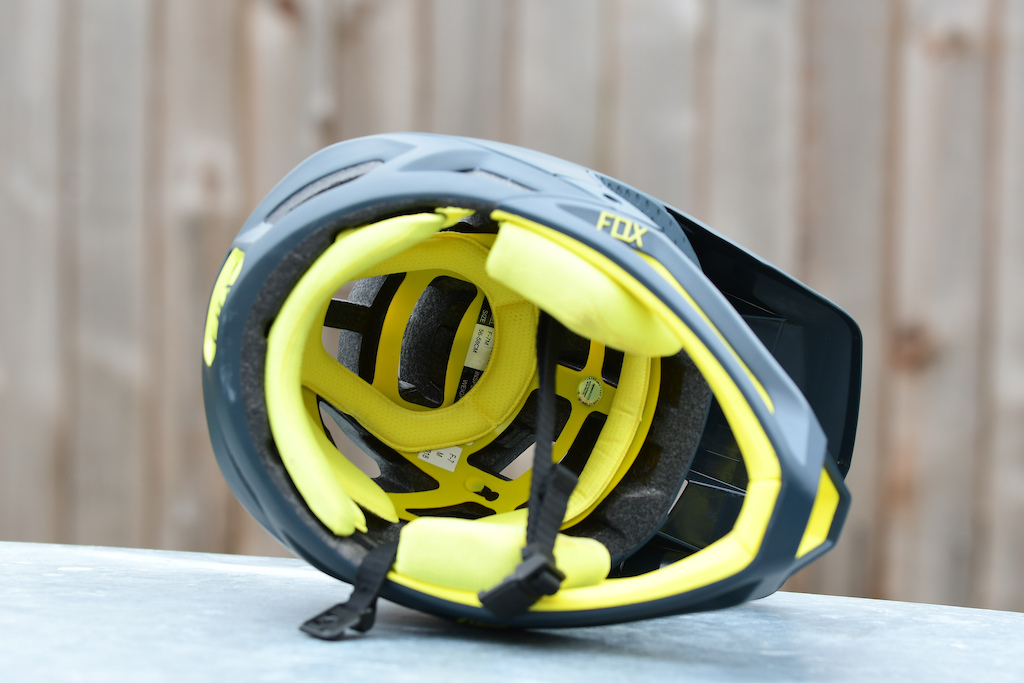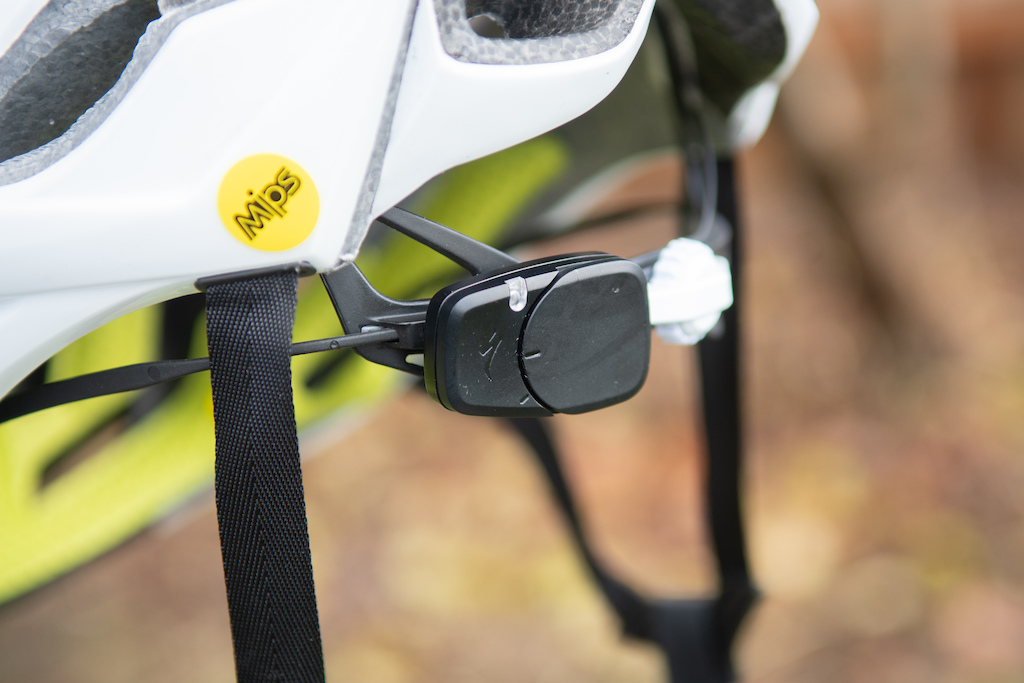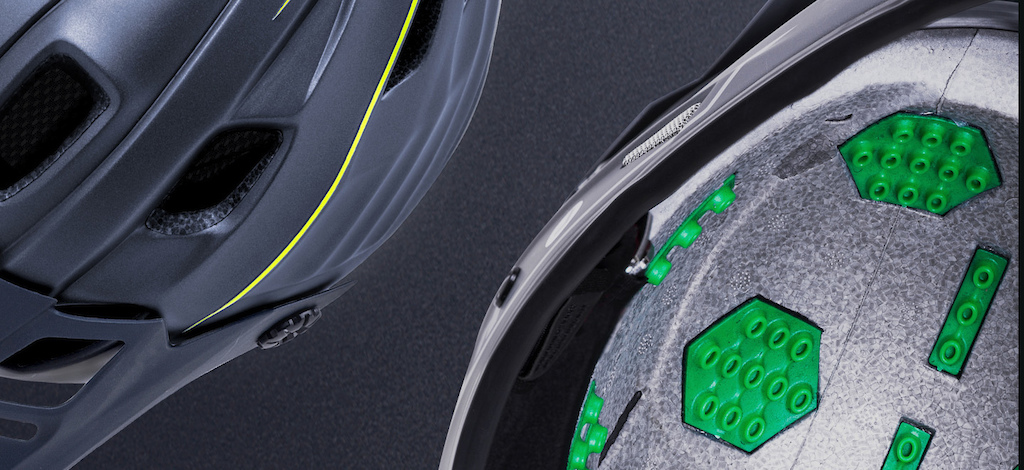Mountain bike helmets have evolved over the years, morphing from what looked like styrofoam bowling balls to the comfortable and well-ventilated options that exist today, many of them equipped with features that are claimed to reduce the amount of rotational force that reaches the brain during a crash. There's still plenty of room for improvement, though, and a significant amount of research and development is currently underway in order to figure out what more can be done to keep riders' heads as safe as possible.
What will the helmets of the future look like? Will they all have electronic sensors to determine when a crash occurs? It there a new material that can absorb impacts better than the EPS and EPP foams that currently prevail? In order gain more insight, I asked several of the key players in the helmet world what their thoughts were on the future of helmet safety.
What's next for mountain bike helmet safety? Now that technologies that are designed to reduce rotational impacts have become commonplace in higher end helmets, what comes next? Do we need more stringent standards? Are there any materials in the pipeline that could improve the level of impact protection?
Dr. Chris Leatt - Founder, Leatt Corporation  | We are constantly evaluating different technologies that help reduce rotational energy (angular velocity) and rotational forces (from angular acceleration) during impacts. The “best practices” test methodology on this is still a work in progress and there is a healthy debate in this regard within the helmet manufacturing and homologation community. We believe that the test standards should be revised to include rotational type testing, as well as other test methods, that would help evaluate the helmet’s ability to mitigate the chance of concussion or serious head / brain injuries. In this regard Leatt’s Turbine technology not only mitigates rotational acceleration, but also low velocity linear (non-rotational) acceleration that has been shown, if repeated, to have cumulative effects on the frequency and severity of concussion and chronic traumatic encephalopathy (CTE), as has recently become evident in American football. This applies across our product and price range.
From a homologation standpoint, The Fédération Internationale de Motocyclisme (FIM) is leading the way with their new FIM Helmet Certification Program (FHCP). There are also several other working groups, linked to regulating bodies and organizations (involved with helmet test standards), that are actively discussing the effects of rotational impacts and ways to incorporate them into existing helmet test standards and develop new ones.
At Leatt we are constantly innovating and looking at new ways; be it new materials, novel application of existing materials or advanced designs, to improve the impact protection levels for all helmets in our product line. Leatt has the latest FIM spec test rig and the ability to test our theories and prototypes for reduction of low and high speed linear and rotational acceleration. |
Peter Halldin - Co-Founder and Chief Technical Officer, MIPS  | As one of the founders of the MIPS company, I have been trying to understand how the brain works and how we best can prevent injuries to the head and the brain since 1996. The work since then has been dealing with a lot of different helmet related research questions for each specific helmet segments. When it comes to MTB helmets and the accident situation, there are no reports on how a typical MTB accident occurs. The only thing we know of today is that you can fall onto a number of different objects like sharp stones, branches to softer gravel or clay.
So, how can we make helmets safer?
I think the answer is to create test standards where we challenge the helmet the most in the test lab before it ends up on a rider in the forest. The helmet standards used today are developed for road bike helmets with the knowledge that the helmet organisations had 20-‐30 years ago. Today we know more about the head and the reason for brain injuries like concussion. We know that most brain injuries are caused by the rotational part in the impact. The helmets today are good but are only optimized to reduce the risk for a skull fracture. We should of course keep the level of safety that we have in our helmets today but also add a test for rotation.
There are different concepts on the market that are designed to reduce the risk for rotational head injuries. MIPS is one example, and has been developed since 1996. In the MIPS in-house test lab, we test the helmet for a 45-degree impact to a hard surface. This could mimic falling on a smooth rock in the forest. We measure the linear and rotational acceleration over time and make sure that the energy is reduced in the experimental head. For a future test method developed for MTB helmet I propose to keep the test method that we have today but to complement with a 45-degree impact surface.
Another important aspect is the test line on the helmet. MTH helmets do often cover a larger portion of the head compared to a conventional bike helmet. This is good but the test line should be lowered in future test standards. Another feature to improve safety is to equip the helmet with sensors that can alarm when an accident has occurred. There are a couple of interesting systems that will trigger in an impact situation and through Bluetooth and a mobile phone alert a relative or a rescue team. |
Dave Ahumada - MTB Global Marketing Manager & Chris Blum - MTB Global Category Manager, Fox  | At Fox we are continuing to focus on multiple directions for helmet safety. Being part of an organization driven by our motocross division we have multiple decades of experience and knowledge in both MX and MTB helmets we use as a foundation for future projects. This experience has allowed us close working relationships with some of the leading helmet and material manufacturers in the world which allow us a unique point of view on the dirt focused two-wheeled markets. These relationships have yielded multiple innovations in our helmet design process which have elevated our performance in the category. Moving forward we plan to continue to leverage these partnerships while we seek out new processes which will allow us to continue to improve the performance and safety for our mountain bike consumers.
A particular point of focus will be to continue to evaluate and refine the rotational force management applications we use in our helmets. We are working to better understand how rotational forces can be measured to ensure our products are performing at the highest levels. Some great work is being done in the areas of testing in projects such as the recent Virginia Tech helmet ratings program. This type of information is crucial to our ability to increase the performance and safety of our products in future seasons.
Additional opportunities we are interested in is how technology can improve the riding experience, both from a safety as well as an experience standpoint. What would a “smart” helmet look like? What additional functional attributes could be created or improved by collecting data through integrated technology in helmet systems? The technological enhancements in other industries such as medical, electronics and manufacturing are creating innovations at a dizzying pace which just a decade ago were thought impossible. (e.g.: Folding, stretchable mobile phones are only a few years away…) Could we create a liner system controlled by an accelerometer which changes density in a nanosecond based on the data received during a crash? Thereby shifting the optimal amount of impact resistance to when and where it is most needed? While this type of technology may be far off in current terms, we believe this type of thinking and exploring will drive tangible innovation in the near future. We’re excited about the possibilities. |
Oscar Huss - Director of Product Development, POC  | Helmet design and materials have rapidly evolved over the last few decades. Safety remains the prime issue and should be the starting point for all helmet development plans, but it’s fair to say that discipline specific designs, weight, ventilation, fit, etc... are increasingly important considerations.
What we also see is that as our ability to understand the brain and impact trauma evolves, through enhanced medical techniques or clinical surveillance, the effect of a head injury various significantly from one person to another, i.e. a rider hitting his/her head at various forces will result in wildly different effects and consequences. This understanding shows us that we need smarter helmets that can do much more than manage a linear and oblique impact only, but can equally talk or work for you before and after you have had an impact. We have already introduced helmets with digital integration and the future will certainly be more in line with that, whilst being focused on a more personalized protection system so the user will be able to better understand the consequences of a fall to them.
We will certainly see materials change significantly as new technologies come forward. Helmets have used many advanced materials, e.g. it’s not uncommon to now see helmets with carbon, aramid, m-forge, dual density liners, etc..., but as new techniques and materials come through we are likely to see changes to tried and tested materials, especially liners, that have underpinned helmets for many years. On top of that sustainability is a key factor in all our future development work, to ensure helmets have a prolonged shelf life and that they can be re-used or recycled once they are retired. |
Eric Richter - Brand Manager, Giro  | When we look ahead, there are three things that will continue to have the greatest influence on the future of head protection: Standards, Technologies, and Choices.
Helmet standards will continue to evolve as understanding of brain injury advances and as rider needs change and diversify. Giro has a long history of working with standards organizations and we will continue to be involved where we can to help quantify rider needs and advocate for relevant changes. New technologies will continue to be evaluated and existing ones refined, two paths we are constantly exploring in our in-house test lab. For example, the lab allows us to develop new solutions like MIPS Spherical that can enhance protective capability and comfort, and to integrate MIPS in less-expensive helmets so that more riders have access to the benefits of the technology.
Providing riders more choices is a core mission at Giro because everyone wants to be able to choose a helmet that fits their style and their needs – whether that’s a progressive design driven by a really specific need like the Switchblade, or a more timeless design like the Chronicle. As a leader in head protection, we will always be looking at how riders push our products, and looking for opportunities to make helmets that help them get the most out of every ride. |
Craig “Stikman” Glaspell - Global Category Director - Bike, Troy Lee Designs  | So, this is something we come to work every day prioritizing how to elevate protection of our heads. A lot of this results in experiments or ideas that seem so batshit crazy or futuristic that even getting the idea off the ground seems futile, but we try it, sometimes it fails, sometimes it results in great results - one of those implementations was the merging of EPP and EPS layers that we did in our A2 trail helmets. It started as a rogue experiment, and after numerous prototypes and placements of the layers the High Speed (EPS) and Low Speed (EPP) energy management results were remarkable and blew away the competition in the lab. That is something only we offer and is patent pending, but like I said, born out of experimentation.
Futuristic stuff we are prototyping now is showing incredible test results in helmets, impeccable fit and comfort, but is extremely expensive currently and scalability at this moment isn’t optimal, but when it comes to protecting our heads, it is something that Troy is here every day pushing us to discover. We are super lucky that through Troy’s relationships in, and more importantly outside of the bike/moto industry, is part of our strengths, he has access to brands and people that have more access to R&D than we have-something we are thankful for.
You have to keep weights low while having tremendous energy management qualities at an affordable price, I’d say that’s the daily mission; well, and it should look badass and born in artistic creativity too! |
 | Helmets, historically, had one basic function: keep your skull intact. That was true whether you were a knight on a battlefield or a driver at the 24 Hours of Le Mans or a rider dropping into a dicey line on the North Shore. End result? Today’s helmets do a very good job of keeping skulls in one piece. As the medical world began, quite recently, to grasp just how big a problem concussions can be, helmet manufacturers responded by create technologies, such as MIPS, that are designed to reduce the rotational forces strongly associated with concussions. You’ll see technologies like MIPS continue to proliferate and evolve.
The next step forward? Smart helmets that detect when you’ve experienced potentially dangerous forces and which then alert people who can bring you help. We recently launched our line of helmets equipped with ANGi—a sensor connected to our Ride app that turns your helmet into a crash detector, safety beacon, and ride tracker.
If that sounds like an advertising slogan, we’ll just boil it down to the facts: We’re taking crash-detection technology (accelerometers and gyroscopes) and communication technology (your smart phone and an app) and pairing those things with helmet technology, so that your helmet not only reduces your risk of injury, but also reduces the amount of time between you crashing and you actually getting medical care.
Obviously, we’re not the only company thinking of ways to creatively combine emerging technologies. You’ll see more of it in the future. |
Brad Waldron - CEO/Lead Engineer, Kali Protectives  | Safety is our number one goal. We have yet to stall on a technology story because it sells, or a unique advantage given to us in the market… we just continue to make what we believe is the safest helmet. Period. So, when someone asks what’s next in helmet safety following MIPS and technologies focused on rotation, we believe what’s next for the industry is something we’ve had since 2012. Making the helmet softer the closer you get to your head. Implementing what we call, a Low-Density-Layer (LDL) which accounts for both rotational AND low-g impacts.
Research is moving so fast that I’m not sure we could come to a new “standard” that would even remain relevant long enough for it to be of any good. At Kali, we build to a standard that is ever changing based on the technologies available at that point in time. If I’m aware of something better to use but am not using it, then to me I’ve failed as an engineer. That’s my standard. And if we’re just talking testing… test labs have biases and technicians have biases, even if not intentionally. But there are different set-ups and equipment for testing and each test has baked-in biases. Yet, we are learning so much more now thanks to people like Halldin, von Holst, Plant, Morgan, and others that devote themselves to the study of brain trauma and practice of testing.
There are always new materials passing by my desk that have the potential to improve the level of impact protection. I feel strongly that changing materials and processes to be constantly up-to-date is vital. Whatever is the best and safest possible solution, that is the solution I will test and work into our helmets. I believe wholeheartedly that our LDL, Composite Fusion and Nano Fusion technologies are the very best and safest technologies that we can offer and using the safest materials we have available. However, if I prove-out a new and better technology/material tomorrow, you can bet your ass you’ll see it worked into our line. |










Probably doing better than ever, if you’re using compensation as an indicator of how life is going. Good for him.
ONE OF US!
Vernon used to be one of the straightest talkers in the community - do you think he looks into the mirror and calls himself out on this drivel?
I was way more shocked when RC wrote that he can't live without electronic suspension - definitely that was the end some era for me.
a href="https://www.youtube.com/watch?v=TpnzubtUX3s">https://www.youtube.com/watch?v=TpnzubtUX3s/a>
As for conspiracy -- man, I don't think that's the case. These established companies, like Bell for example, are not in it to make a cheap, fast buck. Helmets have been their business for decades and decades. I truly believe they are in it for the right reasons -- to provide us with safest helmets for our needs at competitive prices. They have a mission. They have a reputation to uphold. Everything they come out with is not the ultimate solution to every danger, but it is researched and the best they can do given the technology. And if someone comes up with something better, they better keep up, or go out of business. And to be clear, I'm just using Bell as an example of a company that has been around a while. It can be any of these established companies. They want to be competitive and make money, but they also sincerely want to keep you as safe as their technology will allow. I believe that.
We call it composite fusion:
kaliprotectives.com/technology
Hope that helps
So yes... air has a big part in it
vicis.com/products/zero1
If you get CTE from riding a mountain bike, you're doing it wrong (but lucky to be alive after that many collisions)
So cool to see this amount of attention being given to protecting your head!
www.marker.net/en-us/products/helmets/phoenix-map-3857
Also, thank you for the reply!
Helmet. It was hard to find but I think this is what kali was referring to. I’m not convinced it would be the best application for mountain biking but it does solve the problem of being used for multiple impacts.
It's okay, it's a bit pricey and pretty heavy, but still, pretty cool. Just does a point-to-point live connection between helmets, and acts as a bluetooth headset for your phone.
www.amazon.com/BONX-Cancelling-Multifunction-Group-Talking-Snowboarding/dp/B0787Y6R55
you can get cheap ones on aliexpress for 50$. I used one on my Motorcycle with my Girlfriend and have a second bracket to attach it to my dh helmet (used for music in that application) ..on a trail type ehlmet it would be a bit more difficult does to not having a place to place earphones and mic...
www.coros.com/mountain.php
Can’t wait !
But helmets only work when used. More and more I see videos of riders who carry their helmet on the ride up; even hydration packs feature helmet attachments. This is bad. When I was associated with a particular race, the only fatality we had was when a rider fell on a rock in a gravel parking lot while going to the spaghetti diner.
I see a lot of helmet features in the future - bluetooth sound, heads up display, and I would like to see the helmet's safety increase by integrating neck and collarbone protection - the other two major injuries that could be easily addressed.
There are a percentage of crashes where you won't need a helmet to avoid injury, probably fairly high - subtract your guess from 100%
There are a percentage of crashes where the most expensive and heavily marketed helmet isn't going to matter, thankfully very small - subtract that guess from the previous remainder.
There are crashes where the helmet you have now, made from pennies a pound plastic refinery products, is good enough - subtract your guess from the remainder of above.
What you're left with is a very narrow band of situations where something could have possibly been done (costing a buck or two) to improve the outcome, but would that something have been a trade-off that increased probability of an injury in another case? Maybe protection from a softer energy absorbing shell that increases chance of getting crushed hitting a sharp rock?
1. make helmets able to handle multiple impacts
2. make them recyclable so if you can't re-use them after a crash, they at least won't go to a landfill
3. or a trade in program so if you crash, you can send in your old busted helmet for a discount off a new one
Granted you'll look like Dark Helmet when riding
I'm tempted to get your Maya helmet because of the replacement program but I'll always keep a fresh helmet (the cheap On-One or Carnac enduro type POC lookalike helmets) spare so that whenever I need to return the helmet I still have something to ride in.
As for the weight weenies out there... go to the gym. As a mil dude, we wear heavy ass ballistic helmets with all kinds of shit strapped to them for multiple hours on end - it starts with a Night freefall jump, hard ass landing then hours of patrolling on foot to an assault followed with a long ass helo ride out. But I digress. My point is a few ounces for safety aint shit!
the objective itself should be simply stated as : preventing concussion. end of story. No one is saying it's easy, or even possible. But if we all accept that concussion, especially repeated concussion, is the threat, then the design objective has to be to prevent it. and if we cannot design away that risk, then so be it. But let's not pussyfoot with incremental re-spinning of existing tech as if it's new and fresh. Even with MIPS, there's no prevention of concussion, just mitigation. aka, you are still at risk of developing complications therefrom.
that's my challenge to those to whom I do, and still pay top dollar to for protecting my noggin.
kaliprotectives.com/technology
Happy to answer any questions you may have
I've been wearing a dirtbike helmet since I've started down hill many years ago because my though was:" If I can wear it for 30 minutes jumping on a dirt bike, I can wear it for 4 minutes either".
I think the biggest safety improvement would be to reduce cost for wider acceptance. It seems close to half of the riders in "Friday Fails" are not wearing helmets. Second would be designing a helmet to be safer for multiple impacts.
Everyone knows that helmet material cost is very low. If companies kept the same low priced model hemet around for 5 years instead of 1 or 2 they could more easily amortize their mold and labor costs.
Really cool helmet tech that couldn't get its funding....as opposed to the sweaty hair MIPS that was showered down on us like a golden...rod of forced technology....I don't know where that was going....but I wish I had a production Umbo helmet.
I’ve written off 3 helmets in big impacts but have thought about using them again as there is little visible damage, I can see the foam has damage but from the outside they looked fine.....
We can do better.
The test apparatus shown also look totally ridiculous.
Someone start a go fund me. helmet mounted action camera with accelerometers and black box and a small secondary camera watching the hemet. Send the data and injury details to a central data base....get a discount on a replacement helmet. Give the guys working on this a pile of real world data.....GoPro Here's looking at you.....
www.pinkbike.com/news/pinkbike-poll-what-injuries-have-you-received-while-mountain-biking.html
@mikekazimer: typo in the opening sentence?? Step your game up!
If you want something similar in the MTB world you may be interested in seeing this... kaliprotectives.com/technology
Why don’t Kali certify their helmets to AS/NZS 2063?
Alerting those nearby for to your impending doom and saving valuable time to react and bail.
hovding.se
My crotch tho
videos.mtb-news.de/10524/whats_next_
You’re talking about the helmet falling off your head, is it possible that you have forgotten to zip it up or it fell down despite it was fasten?
That was my second lesson from this jump. My strap was loose. It was closed, but not tided enough. As a dj rider who uses only an openface helmets I would never thought that’s so important to have it tided be safe. I was lucky.
kaliprotectives.com/technology
I sustained a fair few concussions (though most of them not even cycling related but stuff like being hit by a car when crossing the street as a kid, fainting and hitting my head against a flowerpot on the way down, stuff like that) and I'm disappointed to learn years later what a concussion actually is (through an article by Danielle Baker here on Pinkbike). Either way, one comment that often comes up in these discussions concerning slip layers is that hair does basically the same as the built-in slip layers. I've got a lot of hair and usually stow it in a Buff-type bandana to keep it in check before I put on my helmet. So I was curious, has anyone ever tested the effects of hair vs a bald crash-dummy inside a slip-layer equipped helmet? Of course in engineering "natural material" is considered unpredictable and I understand if you don't want to make hard statements as a professional. But could you release anything in the general sense? How does 20-30cm long curly hair inside a helmet compare to the commercial slip layers when talking about protecting the brain against rotating impacts?
Concerning the self healing materials, yeah of course we'd all hate to dispose of our helmets after a crash. Or even more importantly, if you crash in the middle of a ride, you still want to make it back to the trailhead so at the end of the day you still would like to have an effective helmet after the impact. Self healing sounds cool in that respect. I suppose the challenge is going to be that most of these helmet materials are foamy plastics. I can imagine they'd heal but the more challenging bit would be whether the healed bits would still be foamy.
Self healing foam. Yes this is what we at Kali consider to be a "what's next" kind of project in helmet safety. Right now, when we are able to construct a helmet using Nano Fusion, the foam actually does return to its original shape and strength after impact. So it truly has potential to be a multi-impact helmet without compromise. The hard part (as mentioned) comes down to the production and it being nearly impossible to work with when constructing the helmet... this is what we now are working towards perfecting
Marketing aside, what Felton says, at least initially, has a lot of merit: all testing standards I'm aware of are about preventing skull fracture, and nothing else. They were all developed back when the treatment for a concussion was "walk it off".
Of course, when you ask industry, you aren't going to get a straight answer. You honestly think anyone they asked would answer "well, yes. We do have an idea how to make our products better, but we aren't doing it."